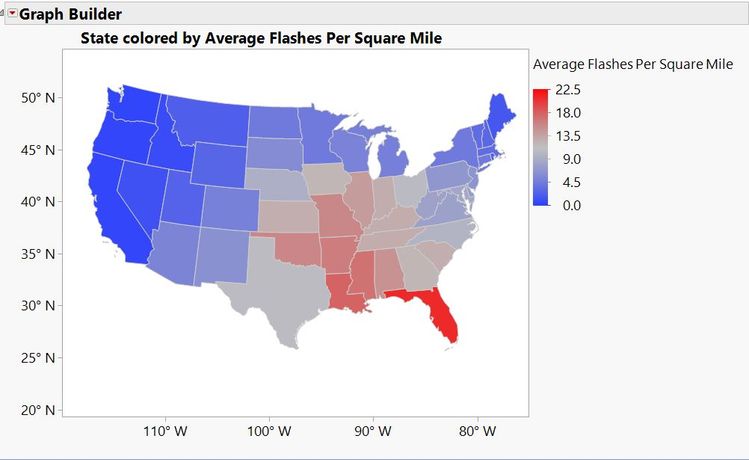 What parts of the US see the most lightning strikes? (Image from Wikipedia. By Jessie Eastland - Own work, CC BY-SA 4.0, https://commons.wikimedia.org/w/index.php?curid=44273148)A couple of years ago, my youngest son had a school project for physics class, and he chose to present on lightning. In the process of his research, my interest was “sparked” by the statistics we found, and I decided to use JMP to help visualize what we were learning.
What parts of the US see the most lightning strikes? (Image from Wikipedia. By Jessie Eastland - Own work, CC BY-SA 4.0, https://commons.wikimedia.org/w/index.php?curid=44273148)A couple of years ago, my youngest son had a school project for physics class, and he chose to present on lightning. In the process of his research, my interest was “sparked” by the statistics we found, and I decided to use JMP to help visualize what we were learning.
Lightning is one of nature’s gifts best experienced from a distance. It can be beautiful and terrifying at the same time. When you see the flash and then immediately hear the crash of thunder, and when the shelter you are in shudders from the force of the ensuing shock wave, you know you have just had a close call with a lightning strike. There are about 1.4 billion lightning strikes per year worldwide.
In the United States, we have our fair share of thunderstorms and lightning. Some states see thunderstorms almost year-round, and others rarely see any at all. An effective way to get an idea of where lightning happens the most in the US is to visualize it via graphs.
Below are some the graphs I generated with Graph Builder in JMP for lightning data by state from 2005 - 2014. The first set shows average lightning strikes per square mile by state. There is a more recent update for the period of 2007 - 2016 for comparison that you can find at the NOAA website.
Vaisala Inc. pulled the data from the National Lightning Detection Network®, which measured the cloud-to-ground lighting flashes over the land area inside state borders.
Let’s look at how the data falls out and what we can learn from it using Graph Builder. This could be especially helpful if you are working on your vacation plans for 2018.
First off are average flashes per square mile. Florida tops the charts on this one.
 Average lightning strikes per square mile by state
Average lightning strikes per square mile by state
Next is a confirmatory bar graph that shows the breakdown by state. It looks like somewhere in the Pacific Northwest or upper New England would be your safest bets for experiencing the least amount of lightning.
 Average strikes per square mile by state
Average strikes per square mile by state
Looking at the graphs above, you might wonder why Florida isn’t called the Lightning State as opposed to the Sunshine State. I am certain the Florida Chamber of Commerce would have something to say about the lightning nickname.
The next two graphs show average lightning strikes per year by state.
 Average lightning strikes per year by state
Average lightning strikes per year by state
 Average strikes per yer by state
Average strikes per yer by state
These graphs tell a bit of a different story. Texas by far has more lightning strikes per year than Florida and Oklahoma combined. Of the more than 220 million lightning strikes on average in the continental US, Texas accounted for approximately 13.6% of that total over the period from 2007 - 2016. As Texans will tell you, “everything is bigger in Texas.” This fact, however, gets washed out by the sheer size of Texas when looking at graphs of average flashes per square mile. Texas ranks 16th in average flashes per square mile.
 Average lightning strikes per square mile by state
Average lightning strikes per square mile by state
Next steps here could be to break down the number of lightning strikes by county or maybe even by city to get a better picture of where lightning happens most often.
One of the important points out of this exploration is to look at your data in multiple ways, always using confirmatory statistics to go along with your descriptive visualizations. It will help you tell the complete story.
Fun fact from Wikipedia: Lake Maracaibo in Venezuela has more lightning strikes than any other place on earth. Lightning occurs on average 297 days per year, and there are about 603 strikes per square mile there. That is approximately 30 times more lightning per square mile than what Florida sees.
Lightning might be one of nature’s true phenomenon, but be careful. Remember this rhyme: “When thunder roars, get indoors.”
P.S. My son’s interest in weather, storms specifically, has only grown stronger. He is now studying meteorology in Oklahoma. Check out the graphs above to compare Ohio and Oklahoma, and you can see why!
 Remember: “When thunder roars, get indoors.” (Image from Wikipedia. By Yintan - Own work, CC BY 4.0, https://en.wikipedia.org/w/index.php?curid=52972095)
Remember: “When thunder roars, get indoors.” (Image from Wikipedia. By Yintan - Own work, CC BY 4.0, https://en.wikipedia.org/w/index.php?curid=52972095)